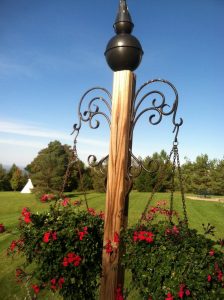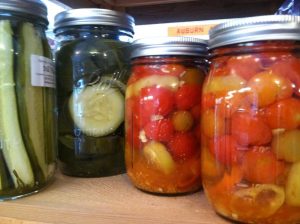
Gardening for me is therapeutic, zen for body and soul. Something about getting dirty and working the earth. Planting, growth and reaping the rewards or lack thereof, I’ve had those too! I’d like to share with you my garden adventures here. Building stone walls, putting in new flower gardens and tending to my kitchen potager. I’ll share my tips on gardening and welcome your feedback as well.
Hanging Plant Post
Bulbs
October is the perfect month for planting spring bulbs in the northeast. Since bulbs are some of the easiest plants to grow, deciding what to plant can be the most difficult decision. Tulips, daffodils, hyacinths and crocus are among the most common spring bulbs in the northeast and when planted correctly will give a satisfying show of color come spring. Be sure to refer to a fall planting map to know what bulbs will grow best in your region. Remember these simple pointers when planting: Plant bulbs within relative close proximity. Bulbs will display best when planted in large groups or areas. This will give a bigger color impact come spring. Do not plant in rows or sporatically one here or there, the result will look unnatural and lack-luster. This is especially true with daffodils which naturally grow in clusters. If you are in a deer prone area – well I hate to tell you – but try to resist tulips altogether or else plant in an area where you know the deer will not be able to reach. Unfortunatly deer love tulips, as much as we do! However, not to worry, they are not fans of daffodils or crocus. Plant all bulbs in well drained soil.
Daffodils are among the easiest bulbs. They are true perennials, that is that they will return year after year with more blooms. Once you put them in the ground your work is done. Again, plant somewhat close together for best impact.
Tulips are also perennials, but can be fickle. It is best to choose tulips that are labeled for naturalizing. This means that they are a better choice for a return bloom year after year. Specially hybridized tulip bulbs usually require being dug up, dried and replanted each fall.
Crocus and hyacinths are also especially low maintenance bulbs. Both deer resistant and return year after year. Grape hyacinths are small and like daffodils, will propogate more and more each year. They can also be planted right in with grassy areas since the actual plant is grass-like in appearance. They look darling planted in large clusters and will give a beautiful purple show.
Remember to follow package directions on depth and whether to fertilize when planting. Come spring you’ll be happy to reap the benefits with the early show of color to your landscape.
Fall is for planting
I’m sure you’ve heard that saying before and it is especially true in parts of the country that receive a significant amount of snowfall. Most nurseries still have abundant plant choices at this time of year. The benefits of fall planting are plenty: you don’t have to do any extensive watering, since the plants are preparing to go dormant. They will have the winter to ‘root in’, so that come spring they should be fairly well established producing a healthy first year plant. No need to mulch, fallen leaf debris around the base of the plant will help to protect it over the winter, deal with the mulch in the spring. When buying bushes and trees, most nurseries will have a one year guarantee. Tear off the label on the plant and staple to your receipt, circle the date and file. I have a file especially labeled for purchased plants. That way if your plant doesn’t make it, you can return it. Some nurseries will want you to return the plant as well – not a problem, just uproot and place in a bag along with your receipt and label. I personally have never had a problem with this, many stores are very good with their customer service and satisfaction. This is also a great time to split hostas. Hostas are a beautiful plant that come in many varieties and hues. Wait until the leaves have almost all wilted, split the plant right down the middle with a sharp shovel or spade. Yes, you’ll hear crunching and such, not to worry, you’re not doing any harm. Replant one of the sections in another location. Hostas can grow quite large and will actually benefit from splitting. Now you have more plants for your garden or to share!
Clean up
It’s that time of year again. Time to put the garden to bed. If you have a vegetable garden be sure to mix some compost or other soil enhancer into your beds after you have removed the plants. It is always wise to toss tomato plants away, be it in nearby woods or onto the curbside pick-up. Sometimes they can have a blight which can contaminate the soil for the next years’ crop. Cut back herbs such as oregano, thyme, winter savory. If you grow mint, be sure to prune that very radically – it can take over in no time. Now it’s time to savor the yields and look forward to next year.
- caption
To cut down or not to cut down..?
OK, here I have a question. I am usually a pretty solid green thumb, however, I am constantly perplexed by this simple question. Hydrangeas, the beautiful blue (or pink, depending on the acidity of your soil). When the season has ended, cut them back completely, partially or just leave them alone? I have to admit, I’ve tried all the above and have either caused them not to bloom, ended up with a lot of stalky wood or killed them completely. I live in the northeast and have some severe winters, nonetheless they do thrive in our zone. I have glorious white hydrangea bushes, lace-cap hydrangeas (that do very well – except when my little deer families are having them for breakfast) and a very showy tree. Any comments to share?
Summers’ last harvest

Harvest time from the potager. Undoubtedly, home-grown tomatoes fresh and warm from the garden, are the ‘taste of summer’! Remember to take those almost red tomatoes that have fallen off the vine to ripen in a sunny window. Serve simply as a side dish sliced and sprinkled with fresh ground sea salt, drizzle with olive oil and a sprig of rosemary.





